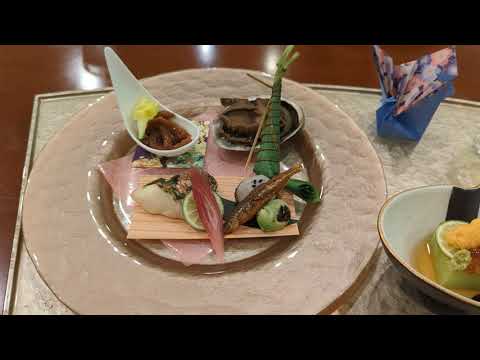We enjoyed a very nice Japanese Kaiseki dinner while staying at Atamiso (熱海荘), a boutique luxury ryokan in Koriyama, Fukushima (福島県郡山市) in the Tohoku region of Japan. The executive chef Satoshi Asano (浅野 智) personally served every course to us, and meticulously explained each offering. While the menu as well as the explanations were all in Japanese, I’ve tried my best to summarize each courses in both English and Japanese. They are:
COURSE 1 – SAKIZUKE (先附 – Appetizer):
* Ao Endomame Tofu (青えんどう豆豆腐 – Endomame Pea Tofu)
– Uni (雲丹 – Sea Urchin)
– Ikura (いくら – Salmon Roe)
COURSE 2 – HASSUN (八寸 – Second course / Seasonal platter):
* Madai no Kinome-yaki (真鯛の木の芽焼き – Japanese Red Sea Bream grilled with the Young Leaves of a Sansho Plant)
* Ika Sansho-zuke (烏賊三升漬け – Simmered Squid with Sansho Pepper sauce made together with Soy Sauce and Sake)
* Awabi Umani (鮑旨煮 – Simmered Abalone)
* Sasa Chimaki-fu (笹粽麩 – Raw Wheat Gluten wrapped in Sasa (Broad-leaf Bamboo) leaves)
* Ishikawa Koimo (石川小芋 – Steamed and salted Satoimo Japanese Taro)
* Hibara-ko Wakasagi Kanro-ni (桧原湖公魚甘露煮 – Japanese Smelt from Lake Hibara simmered in a mix of soy sauce, mirin or mizuame syrup)
* Sudori Myoga (酢取茗荷 – Myoga Japanese Ginger flavored with Amazu Sweet and Sour Vinegar)
COURSE 3 – HIRAWAN (平椀 – Wooden flat bowl dish):
Aizu Kozuyu (会津こづゆ – A local soup dish that used to be served to the Lord of Aizu):
Hotate Kaibashira dashi base (帆立貝柱出汁ベース – Soup base is made from Scallops)
– Mame-fu (豆麩 – Wheat Gluten mixed with green beans)
– Daikon (大根 – Daikon Radish)
– Ishikawa Koimo (Satoimo) (石川小芋(里芋) – Satoimo Japanese Taro)
– Ninjin (人参 – Carrots)
– Warabi (わらび – Bracken)
– Kikurage (木耳 – Wood-ear Mushrooms)
– Shirataki/Ito Konnyaku (しらたき/糸こんにゃく – Noodles made from Konjac Yam)
– Ginnan (銀杏 – Gingko Nuts)
COURSE 4 – OTSUKURI (お造り – Sashimi):
* Hon Maguro Hirazukuri (三崎港本鮪平造り – Bluefin Tuna from Misaki-ko Port in Kanagawa)
* Shiro Mirugai (白海松貝 – White Geoduck)
* Iwaki Hatsu Katsuo Sashi (いわき鰹刺し – Bonito Sashimi from Iwaki)
* Iwaki Hirame Kobujime (いわき平目昆布〆 – Konbu Sea Kelp-cured Flounder/Sole/Flat Fish from Iwaki)
* Nagasaki Shime Saba Aburi (長崎〆鯖炙り – Cured and Seared Mackerel from Nagasaki)
COURSE 5 – MUSHIMONO (蒸し物 – Steamed Dish):
* Kani Chawanmushi (蟹茶碗蒸し – “Chawanmushi” Savory Egg Custard)
COURSE 6 – YAKIMONO (焼物 – Grilled Dish):
* Sawara no Kenchin-yaki (鰆の巻繊焼き – Grilled Japanese Spanish Mackerel that is stuffed with Tofu and Vegetables)
– Kinome Miso (木の芽味噌 – Miso paste made with the Young Leaves of a Sansho Plant)
COURSE 7 – DAIZARA (台皿 – Main Dish):
FOR HIM:
* Fukushima Gyu no Yakishabu Shitate (福島牛の焼きしゃぶ仕立て – Fukushima Beef, grilled then Shabu Shabu’d)
FOR HER:
* Aizu Jidori Saikyo-yaki (Misozuke) (会津地鶏西京焼き – Miso-marinated and grilled Aizu Chicken)
COURSE 8 – AGEMONO (揚物 – Fried Dish):
* Sansai Tempura (山菜天ぷら – Mountain Vegetables Tempura)
– Nobiru (のびる – Nobiru is known as Wild Rocambole, and is a Japanese wild plant that’s somewhat similar to field garlic or a long onion)
– Udo (独活 – Japanese Spikenard/Aralia Cordata)
– Gyoja Ninniku (行者大蒜 – Alpine Leek)
– Urui no Ha (うるいの葉 – Hostas Leaves)
– Koshiabura (こしあぶら – Koshiabura is a wild mountain vegetable found in Japan)
– Kogomi (こごみ – Ostrich Fern)
COURSE 9 – SHOKUJI (食事 – Rice Dish):
* Aizu Koshihikari Takenoko Gohan (会津コシヒカリ筍御飯 – Bamboo Shoots with Aizu Koshihikari Rice)
COURSE 10 – TOMEWAN (止椀):
* Akadashi Jitate (赤出汁仕立て – Red Miso Soybean Paste Soup)
COURSE 11 – KOUNOMONO (香の物 – Pickled Vegetables):
* Aizu Sagohachi-zuke (会津三五八漬け – Sagohachi Pickles. Sagohachi pickles are local pickles made with rice koji, salt and steamed rice)
COURSE 12 – MIZUGASHI (水菓子 – Dessert):
* Kisetsu no Kudamono (季節の果物 – Seasonal fruit)
– Orange (オレンジ)
– Midori to Aka Budo (緑と赤葡萄 – Green and Red Grapes)
– Kiwi (キーウィ)
– Dragonfruit/Pitaya (ドラゴンフルーツ)
– Strawberries (苺)
– Watermelon (西瓜)
* Akashiso to Umezuke Jelly (赤紫蘇ジュースと梅漬けゼリー – Jelly made from Red Perilla juice and Salted Ume Plums)

